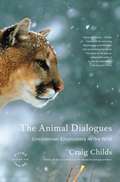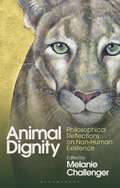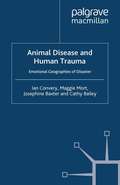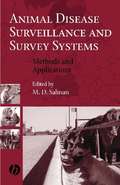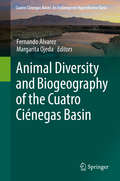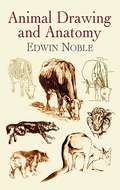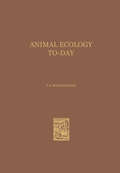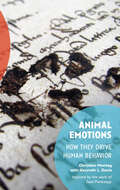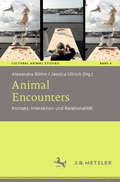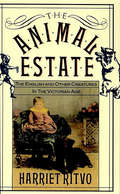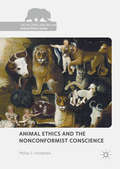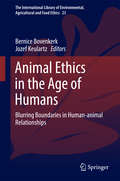- Table View
- List View
The Animal Dialogues: Uncommon Encounters in the Wild
by Craig ChildsFrom one of the finest nature writers at work in America today-a lyrical, dramatic, illuminating tour of the hidden domain of wild animals. Whether recalling the experience of being chased through the Grand Canyon by a bighorn sheep, swimming with sharks off the coast of British Columbia, watching a peregrine falcon perform acrobatic stunts at 200 miles per hour, or engaging in a tense face-off with a mountain lion near a desert waterhole, Craig Childs captures the moment so vividly that he puts the reader in his boots. Each of the forty brief, compelling narratives in The Animal Dialogs focuses on the author's own encounter with a particular species and is replete with astonishing facts about the species' behavior, habitat, breeding, and lifespan. But the glory of each essay lies in Childs's ability to portray the sometimes brutal beauty of the wilderness, to capture the individual essence of wild creatures, to transport the reader beyond the human realm and deep inside the animal kingdom
Animal Dignity: Philosophical Reflections on Non-Human Existence
by Melanie ChallengerHow do we understand the dignity and value of non-human animals? Leading philosophers, ethnologists and writers contribute to this interdisciplinary and wide-ranging account of animal dignity. With a foreword by world-leading primatologist, Dr. Jane Goodall DBE, essays collected here make the case for applying the concept of dignity beyond its usual humanist framework and introduce readers to animal dignity in history, law, science, philosophy, and literature. United in recognizing the dignity of non-human animals, these essays suggest how we might ensure a flourishing environment in times of ecological destruction and climate breakdown. Historians, primatologists, philosophers, novelists and artists approach the concept of animal dignity creatively, offering interpretations that are academically rigorous, alongside ones that are personal and literary. This variety of engagement knits together a fruitful way forward for progressive relations between all species.
Animal Dignity: Philosophical Reflections on Non-Human Existence
How do we understand the dignity and value of non-human animals? Leading philosophers, ethnologists and writers contribute to this interdisciplinary and wide-ranging account of animal dignity. With a foreword by world-leading primatologist, Dr. Jane Goodall DBE, essays collected here make the case for applying the concept of dignity beyond its usual humanist framework and introduce readers to animal dignity in history, law, science, philosophy, and literature. United in recognizing the dignity of non-human animals, these essays suggest how we might ensure a flourishing environment in times of ecological destruction and climate breakdown. Historians, primatologists, philosophers, novelists and artists approach the concept of animal dignity creatively, offering interpretations that are academically rigorous, alongside ones that are personal and literary. This variety of engagement knits together a fruitful way forward for progressive relations between all species.
Animal Disease and Human Trauma: Emotional Geographies of Disaster
by I. Convery M. Mort J. Baxter C. BaileyMany disasters are approached by researchers, managers and policymakers as if they have a clear beginning, middle and end. But often the experience of being in a disaster is not like this. This book offers non-linear, non-prescriptive ways of thinking about disasters and allows the people affected by disaster the chance to speak.
Animal Disease Surveillance and Survey Systems: Methods and Applications
by M. D. SalmanThis valuable text presents methods and techniques for conducting an animal disease surveillance program, and developing an animal health moitoring system. The text is a 'recipe book' for these techniques as it explains modern techniques, while emphasizing the fundamentals and principles of using these techniques.The book is targeted to epidemiologists and other animal health authorities who are working in national, regional, and international programs. The book can be used as a text for professional and postgraduate training curricula. This text will be of value in veterinary epidemiology and regulatory medicine, where there is need for a concise collection of material on animal disease monitoring, surveillance, and reporting strategies. This need arises from a new era of international trade regulations based on animal diseases, new demands for accountability in utilization of research funds, and calls for prioritizing and economically justifying animal health regulatory and diagnostic activities.
Animal Dispersal: Small mammals as a model
by N. C. Stenseth W. Z. Lidicker4.1.1 Demographic significance Confined populations grow more rapidly than populations from which dispersal is permitted (Lidicker, 1975; Krebs, 1979; Tamarin et at., 1984), and demography in island populations where dispersal is restricted differs greatly from nearby mainland populations (Lidicker, 1973; Tamarin, 1977, 1978; Gliwicz, 1980), clearly demonstrating the demographic signi ficance of dispersal. The prevalence of dispersal in rapidly expanding populations is held to be the best evidence for presaturation dispersal. Because dispersal reduces the growth rate of source populations, it is generally believed that emigration is not balanced by immigration, and that mortality of emigrants occurs as a result of movement into a 'sink' of unfavourable habitat. If such dispersal is age- or sex-biased, the demo graphy of the population is markedly affected, as a consequence of differ ences in mortality in the dispersive sex or age class. Habitat heterogeneity consequently underlies this interpretation of dispersal and its demographic consequences, although the spatial variability of environments is rarely assessed in dispersal studies.
Animal Diversity
by Diana R. KershawThis book has been written with two main purposes in mind, page. At the same time animals show immense variation the first being to give a general review of the entire animal and none is truly typical. Some idea of the immense variety kingdom, and the second to give more detailed functional of animals is given in the diversity sections, with a synopsis accounts of the anatomy of a representative of each major of the classification of each major phylum. animal group. It is intended to be used by those who are Zoology has a language of its own, which appears highly interested in animals and does not start with the assumption complicated but in most cases can, in fact, be derived simply of any great zoological knowledge. It is hoped that it will from either Latin or Greek. Translations and derivations prove particularly helpful to those studying biology or have been given of a selection of zoological terms; these zoology at 'A' level, or in the early stages of a university should be regarded as examples. The interested zoologist course. may find the use of a Greek and Latin dictionary rewarding.
Animal Diversity and Biogeography of the Cuatro Ciénegas Basin (Cuatro Ciénegas Basin: An Endangered Hyperdiverse Oasis)
by Fernando Álvarez Margarita OjedaThis volume investigates the contemporary fauna that inhabit the Cuatro Ciénegas Basin. Divided into 15 chapters, it addresses and describes their diversity, taxonomic and biogeogaphic affinities, and ecological characteristics. The Cuatro Ciénegas Valley is a unique oasis in the south-central region of the State of Coahuila, part of the Sonoran Desert, in Mexico. Several clues, specially derived from the study of the microbiota, suggest a very ancient origin of the valley and its permanence through time. This condition had promoted a high level of endemism and led to unique interactions between the resident species.
Animal Drawing and Anatomy
by Edwin Noble"No artist, designer, or craftsman can be regarded as fully equipped without a knowledge of natural forms," asserts this instructive volume. "All forms of life offer rich material for design, whether realistic or conventional," it notes, adding that studies from life "of the human figure, the forms of all animals and birds, and of the inhabitants of the waters, and of plants, must precede mastery of the art of design." With this profusely illustrated guide, beginners can learn the fundamentals of animal drawing, and more experienced artists can find tips that will assist them in refining their skills. Written and illustrated by a distinguished artist and art instructor of the early twentieth century, this volume features valuable insights into reproducing accurate images of horses, cows, dogs, sheep, birds, and wild animals. The explanatory text, highlighted by 233 drawings, offers advice not only on depicting musculature, hair, feathers, and other obvious physical features, but also on such essentials as action, pose, proportions, and character.
Animal Ecology
by Charles S. EltonCharles Elton was one of the founders of ecology, and his Animal Ecology was one of the seminal works that defined the field. In this book Elton introduced and drew together many principles still central to ecology today, including succession, niche, food webs, and the links between communities and ecosystems, each of which he illustrated with well-chosen examples. Many of Elton's ideas have proven remarkably prescient—for instance, his emphasis on the role climatic changes play in population fluctuations anticipated recent research in this area stimulated by concerns about global warming. For Chicago's reprint of this classic work, ecologists Mathew A. Leibold and J. Timothy Wootton have provided new introductions to each chapter, placing Elton's ideas in historical and scientific context. They trace modern developments in each of the key themes Elton introduced, and provide references to the most current literature. The result will be an important work for ecologists interested in the roots of their discipline, for educated readers looking for a good overview of the field, and for historians of science.
Animal Electricity: How We Learned That the Body and Brain Are Electric Machines
by Robert B. CampenotLike all cellular organisms humans run on electricity. Cells work like batteries: slight imbalances of electric charge across cell membranes, caused by ions moving in and out of cells, result in sensation, movement, awareness, and thinking—the things we associate with being alive. Robert Campenot offers an accessible overview of animal electricity.
Animal Electricity: How We Learned That the Body and Brain Are Electric Machines
by Robert B. CampenotLike all cellular organisms humans run on electricity. Cells work like batteries: slight imbalances of electric charge across cell membranes, caused by ions moving in and out of cells, result in sensation, movement, awareness, and thinking—the things we associate with being alive. Robert Campenot offers an accessible overview of animal electricity.
Animal Emotions: How They Drive Human Behavior
by Christian Montag Kenneth L. DavisAnimal Emotions: How They Drive Human Behavior gives a concise overview of ancient mammalian emotions deeply rooted in the human brain. Jaak Panksepp, a world-renowned neuroscientist, dedicated his life career to the study of mammalian emotions and he carved out seven distinct emotional systems he called seeking, lust, care, and play (positive emotions), and fear, anger, and sadness (negative emotions), all exerting a tremendous influence on human behavior.Christian Montag, a neuroscientist and psychologist, and a long-time collaborator of Jaak Panksepp, revisits together with Kenneth L. Davis, one of Jaak’s PhD students, Panksepp’s theories and provides the reader with new insights into the nature of emotions and their role as survival tools, both for animals and for humans. They also raise new questions about the background of the research field Jaak Panksepp coined "Affective Neuroscience." How are personality and psychopathology linked to animal emotions? Do animals feel the same way as we do? What are our emotional needs in a digital society, and what is key to a happy life?
Animal Encounters: Kontakt, Interaktion und Relationalität (Cultural Animal Studies #4)
by Alexandra Böhm Jessica UllrichDer Band bestimmt den Begriff der Begegnung als eigene, bedeutungstragende Kategorie und fokussiert zum ersten Mal systematisch und historisch Fragen der Interaktion zwischen Menschen und Tieren in Philosophie, Kunst, Literatur und in sozio-kulturellen Praktiken. Einzelanalysen untersuchen die Formen und Funktionen der Interaktion zwischen unterschiedlichen Spezies sowie deren grundlegende Muster, die einerseits von Empathie, Achtsamkeit oder Agency gekennzeichnet sind, bzw. andererseits von Gewalt, Ausgrenzung, Widerständigkeit oder Konfrontation. Damit ergänzt die Publikation die Erforschung der Tier-Mensch-Beziehung um den zentralen Aspekt von ambivalenten Interspezies-Begegnungen, die zugleich destruktives und transformatives Potential offenbaren.
Animal Endo-SiRNAs: Methods and Protocols (Methods in Molecular Biology #1173)
by Andreas WernerAnimal Endo-SiRNAs: Methods and Protocols presents a variety of approaches to investigate endo-siRNAs. These include protocols applicable to study short RNAs expressed at a low level and model systems that are particularly suitable to investigate specific aspects of endo-siRNAs, their synthesis, their genomics or regulatory role. Written in the highly successful Methods in Molecular Biology series format, chapters include introductions to their respective topics, lists of the necessary materials and reagents, step-by-step, readily reproducible laboratory protocols and tips on troubleshooting and avoiding known pitfalls.Authoritative and practical, Animal Endo-SiRNAs: Methods and Protocols contains practical tips that are absent in standard lab manuals.
The Animal Estate: The English and Other Creatures in Victorian England
by Harriet RitvoWhen we think about the Victorian age, we usually envision people together with animals: the Queen and her pugs, the sportsman with horses and hounds, the big game hunter with his wild kill, the gentleman farmer with a prize bull. Harriet Ritvo here gives us a vivid picture of how animals figured in English thinking during the nineteenth century and, by extension, how they served as metaphors for human psychological needs and sociopolitical aspirations. Victorian England was a period of burgeoning scientific cattle breeding and newly fashionable dog shows; an age of Empire and big game hunting; an era of reform and reformers that saw the birth of the Royal SPCA. Ritvo examines Victorian thinking about animals in the context of other lines of thought: evolution, class structure, popular science and natural history, imperial domination. The papers and publications of people and organizations concerned with agricultural breeding, veterinary medicine, the world of pets, vivisection and other humane causes, zoos, hunting at home and abroad, all reveal underlying assumptions and deeply held convictions—for example, about Britain’s imperial enterprise, social discipline, and the hierarchy of orders, in nature and in human society. Thus this book contributes a new new topic of inquiry to Victorian studies; its combination of rhetorical analysis with more conventional methods of historical research offers a novel perspective on Victorian culture. And because nineteenth-century attitudes and practices were often the ancestors of contemporary ones, this perspective can also inform modern debates about human–animal interactions.
Animal Ethics: A Contemporary Introduction (Routledge Contemporary Introductions to Philosophy)
by Bob FischerThere are many introductions to the animal ethics literature. There aren’t many introductions to the practice of doing animal ethics. Bob Fischer’s Animal Ethics: A Contemporary Introduction fills that gap, offering an accessible model of how animal ethics can be done today. The book takes up classic issues, such as the ethics of eating meat and experimenting on animals, but tackles them in an empirically informed and nuanced way. It also covers a range of relatively neglected issues in animal ethics, such as the possibility of insect sentience and the ethics of dealing with pests. Finally, the book doesn’t assess every current practice using standard ethical theories, but tries to evaluate some of them using the moral frameworks endorsed by those involved. So, for instance, there is a chapter on the way that animal care and use committees try to justify some of the educational uses of animals, and the chapter on zoos considers the way that international zoological societies justify compromising animal welfare. The book wraps up with a discussion of the future of animal ethics. Each chapter opens with a helpful initial overview of the chapter and ends with a list of suggested readings to help students go further on their own. Key Features Covers animal ethics from an empirically informed perspective, bringing philosophy into conversation with key issues in animal science, conservation biology, economics, ethology, and legal studies, among other fields Provides ample coverage of the most salient current topics, including, for example: Debates about which animals are sentient The suffering of wild animals Research ethics The boundaries of activism Avoids suggesting that animal ethics is simply the practice of applying the right general theory to a problem, instead allowing readers to first work out the specific costs and benefits of making ethical decisions Impresses upon the reader the need for her to work out for herself the best way forward with difficult ethical issues, suggesting that progress can indeed be made Includes summaries and recommended readings at the end of each chapter
Animal Ethics: Beyond Animal Rights: Food, Pets And Ethics (The Basics)
by Tony MiliganAnimal Ethics has long been a highly contested area with debates driven by unease about various forms of animal harm, from the use of animals in scientific research to the farming of animals for consumption. Animal Ethics: The Basics is an essential introduction to the key considerations surrounding the ethical treatment of animals. Taking a thematic approach, it outlines the current arguments from animal agency to the emergence of the ‘political turn’. This book explores such questions as: Can animals think and do they suffer? What do we mean by speciesism? Are humans special? Can animals be political or moral agents? Is animal rights protest ethical? Including outlines of the key arguments, suggestions for further reading and a glossary of key terms, this book is an essential read for philosophy students and readers approaching the contested field of Animal Ethics for the first time.
Animal Ethics and the Autonomous Animal Self (The Palgrave Macmillan Animal Ethics Series)
by Natalie ThomasThis book presents a radical and intuitive argument against the notion that intentional action, agency and autonomy are features belonging only to humans. Using evidence from research into the minds of non-human animals, it explores the ways in which animals can be understood as individuals who are aware of themselves, and the consequent basis of our moral obligations towards them. The first part of this book argues for a conception of agency in animals that admits to degrees among individuals and across species. It explores self-awareness and its various levels of complexity which depend on an animals’ other mental capacities. The author offers an overview of some established theories in animal ethics including those of Peter Singer, Tom Regan, Bernard Rollin and Lori Gruen, and the ways these theories serve to extend moral consideration towards animals based on various capacities that both animals and humans have in common. The book concludes by challenging traditional Kantian notions of rationality and what it means to be an autonomous individual, and discussing the problems that still remain in the study of animal ethics.
Animal Ethics and the Nonconformist Conscience (The Palgrave Macmillan Animal Ethics Series)
by Philip J. SampsonThis book explores the religious language of Nonconformity used in ethical debates about animals. It uncovers a rich stream of innovative discourse from the Puritans of the seventeenth century, through the Clapham Sect and Evangelical Revival, to the nineteenth century debates about vivisection. This discourse contributed to law reform and the foundation of the RSPCA, and continues to flavour the way we talk about animal welfare and animal rights today. Shaped by the "nonconformist conscience", it has been largely overlooked. The more common perception is that Christian “dominion” authorises the human exploitation of animals, while Enlightenment humanism and Darwinian thought are seen as drawing humans and animals together in one "family". This book challenges that perception, and proposes an alternative perspective. Through exploring the shaping of animal advocacy discourses by Biblical themes of creation, fall and restoration, this book reveals the continuing importance of the nonconformist conscience as a source to enrich animal ethics today. It will appeal to the animal studies community, theologians and early modern historians.
Animal Ethics: The Basics (The Basics)
by Tony MiliganAnimal Ethics has long been a highly contested area with debates driven by unease about various forms of animal harm, from the use of animals in scientific research to the farming of animals for consumption. Animal Ethics: The Basics is an essential introduction to the key considerations surrounding the ethical treatment of animals. Taking a thematic approach, it outlines the current arguments from animal agency to the emergence of the ‘political turn’. This book explores such questions as: Can animals think and do they suffer? What do we mean by speciesism? Are humans special? Can animals be political or moral agents? Is animal rights protest ethical? Including outlines of the key arguments, suggestions for further reading and a glossary of key terms, this book is an essential read for philosophy students and readers approaching the contested field of Animal Ethics for the first time.
Animal Ethics in the Age of Humans: Blurring boundaries in human-animal relationships (The International Library of Environmental, Agricultural and Food Ethics #23)
by Bernice Bovenkerk Jozef KeulartzThis book provides reflection on the increasingly blurry boundaries that characterize the human-animal relationship. In the Anthropocene humans and animals have come closer together and this asks for rethinking old divisions. Firstly, new scientific insights and technological advances lead to a blurring of the boundaries between animals and humans. Secondly, our increasing influence on nature leads to a rethinking of the old distinction between individual animal ethics and collectivist environmental ethics. Thirdly, ongoing urbanization and destruction of animal habitats leads to a blurring between the categories of wild and domesticated animals. Finally, globalization and global climate change have led to the fragmentation of natural habitats, blurring the old distinction between in situ and ex situ conservation. In this book, researchers at the cutting edge of their fields systematically examine the broad field of human-animal relations, dealing with wild, liminal, and domestic animals, with conservation, and zoos, and with technologies such as biomimicry. This book is timely in that it explores the new directions in which our thinking about the human-animal relationship are developing. While the target audience primarily consists of animal studies scholars, coming from a wide range of disciplines including philosophy, sociology, psychology, ethology, literature, and film studies, many of the topics that are discussed have relevance beyond a purely theoretical one; as such the book also aims to inspire for example biologists, conservationists, and zoo keepers to reflect on their relationship with animals.
The Animal Ethics Reader
by Richard G. Botzler Susan J. ArmstrongThe Animal Ethics Reader is an acclaimed anthology containing both classic and contemporary readings, making it ideal for anyone coming to the subject for the first time. It provides a thorough introduction to the central topics, controversies and ethical dilemmas surrounding the treatment of animals, covering a wide range of contemporary issues, such as animal activism, genetic engineering, and environmental ethics. The extracts are arranged thematically under the following clear headings:???? Theories of Animal Ethics Nonhuman Animal Experiences Primates and Cetaceans Animals for Food Animal Experimentation Animals and Biotechnology Ethics and Wildlife Zoos and Aquariums Animal Companions Animal Law and Animal Activism Readings from leading experts in the field including Peter Singer, Bernard E. Rollin and Jane Goodall are featured, as well as selections from Tom Regan, Jane Goodall, Donald Griffin, Temple Grandin, Ben A. Minteer, Christine Korsgaard and Mark Rowlands. Classic extracts are well balanced with contemporary selections, helping to present the latest developments in the field. This revised and updated Third Edition includes 31 new readings on a range of subjects, including animal rights, captive chimpanzees, industrial farm animal production, genetic engineering, keeping cetaceans in captivity, animal cruelty, and animal activism. The Third Edition also is printed with a slightly larger page format and in an easier-to-read typeface.? Featuring contextualizing introductions by the editors, study questions and further reading suggestions as the end of each chapter, this will be essential reading for any student taking a course in the subject. With a new foreword by Bernard E. Rollin.
The Animal Ethics Reader
by Richard G. Botzler Susan J. ArmstrongThe Animal Ethics Reader is an acclaimed anthology containing both classic and contemporary readings, making it ideal for anyone coming to the subject for the first time. It provides a thorough introduction to the central topics, controversies and ethical dilemmas surrounding the treatment of animals, covering a wide range of contemporary issues, such as animal activism, genetic engineering, and environmental ethics. The extracts are arranged thematically under the following clear headings:???? Theories of Animal Ethics Nonhuman Animal Experiences Primates and Cetaceans Animals for Food Animal Experimentation Animals and Biotechnology Ethics and Wildlife Zoos and Aquariums Animal Companions Animal Law and Animal Activism Readings from leading experts in the field including Peter Singer, Bernard E. Rollin and Jane Goodall are featured, as well as selections from Tom Regan, Jane Goodall, Donald Griffin, Temple Grandin, Ben A. Minteer, Christine Korsgaard and Mark Rowlands. Classic extracts are well balanced with contemporary selections, helping to present the latest developments in the field. This revised and updated Third Edition includes 31 new readings on a range of subjects, including animal rights, captive chimpanzees, industrial farm animal production, genetic engineering, keeping cetaceans in captivity, animal cruelty, and animal activism. The Third Edition also is printed with a slightly larger page format and in an easier-to-read typeface.? Featuring contextualizing introductions by the editors, study questions and further reading suggestions as the end of each chapter, this will be essential reading for any student taking a course in the subject. With a new foreword by Bernard E. Rollin.
